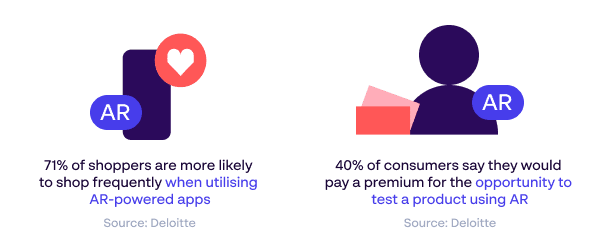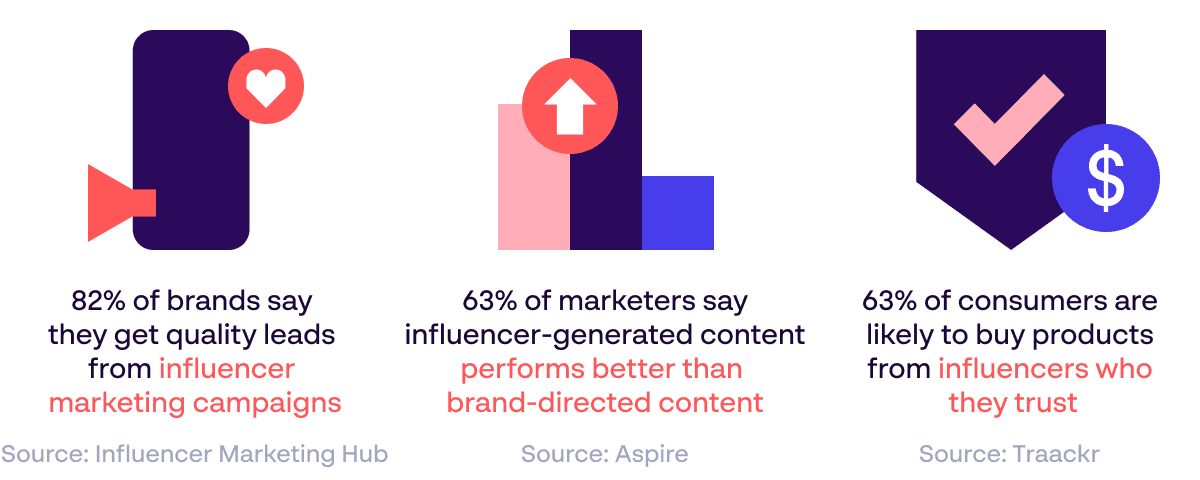The retail ecosystem never stops changing. In the last decade rapid evolutions in technology, shifts in consumer behaviour and global instability have forced retailers to adapt to survive.
Looking at 2024 and beyond, this ever-changing landscape shows no sign of slowing down:
- The emergence of Generation Alpha as shoppers will introduce an entirely new set of consumer demands and expectations
- The power and accessibility of technology is reaching new untold heights
- The balance between physical retail stores and e-commerce is in flux
- Customers are more conscious than ever about the social, environmental and ethical impact of the retail industry
Taking these overarching patterns into account, combined with our decades of working with retailer brands and marketers, we’ve identified 6 standout retail trends that you should stay on top of this year and in the years ahead.
Are you ready to embrace the future of retail? Start your journey below.

Retail trend #1 – The value of omnichannel retailing
Omnichannel retail. Hybrid shopping. Phygital retail. However you choose to label it, modern retailers must prioritise multichannel marketing to enhance customer experiences across the board.
Today, over 73% of retail consumers use multiple channels in their shopping experience, while 95% review products online before they buy. Gen Z and Gen Alpha identify products on their mobile devices, research these on search engines, test them out in physical stores, and complete the purchase online.
These multilayered journeys are far from uncommon for the latest wave of shoppers, which is why terms such as “showrooming” and “webrooming” have entered the retail vocabulary.

“Smart store” is another emerging phrase. These are brick-and-mortar stores that incorporate technologies to enhance the shopping experience, from smart sensors and cashier-less checkouts to interactive digital signage, mobile apps that work in-store and beacon technology.
As retailers aim to appeal to different generations of consumers, omnichannel retailing integrates multiple touchpoints to give customers flexibility, information and more seamless shopping experiences. And many successful retailers are already taking strides in this direction:
- Starbucks’ physical and mobile customer cards allow users to accumulate reward points that they can spend in-store or online, while their app enables them to find menu options in their local cafe or add songs playing in-store directly to their Spotify playlist
- Sephora’s Beauty Insider loyalty program lets users shop directly online, scan in-store items to explore alternative options, watch tutorial videos and gain reward points for discounts, capturing over 11 million members
- Timberland utilises near-field communication technology to give in-store shoppers access to tablets that explain more about the products they’re browsing, allowing them to shop independently and get personalised product recommendations
These are just some notable examples, but the reach of omnichannel permeates every level of the modern retail industry. So, to appeal to the next generations of shoppers, you must offer multiple routes across their purchase journey:
- Unified shopping carts that allow people to purchase in-store or online
- Geolocation technology that sends push notifications with personalised offers when customers are near a physical store
- Digital in-store kiosks where customers can browse your catalogue and check inventory
- Virtual fitting rooms that allow shoppers to try on clothing digitally
- Click-and-collect delivery where customers can buy online and pick up in-store
- Integrated loyalty programs that let customers gain points to use in-store or online
Consistency is also key to ensuring each component of your omnichannel network is aligned and trustworthy. Using brand management technology can help marketers maintain the harmonious presence that today’s customers demand.

Retail trend #2 – The explosion of generative AI in retail
The rapid evolution of artificial intelligence (AI) is touching every area of the world, and the retail industry is no different. A reported 40% of American retailers currently use AI solutions in some form, a number set to grow exponentially in the next few years.

Why is it on our trending list? Because the power of AI is already revolutionising the retail experience in numerous ways:
- AI algorithms analyse consumer behaviour to deliver more personalised shopping experiences – from relevant product recommendations to seamless buying journeys
- Chatbots, virtual shopping assistants and similar aids offer 24/7 customer support and personalised shopping advice, efficiently guiding customers on their path to a purchase
- AI tools can assess historical data to forecast sales demand for products and services, allowing retail marketers to tailor campaigns and promotions based on these predictive insights
- AI applications such as smart mirrors, automated checkouts and personalised in-store recommendations enhance physical shopping experiences
And this is just the beginning. With the speed and capabilities of AI platforms doubling every 3 months, retailers will soon be able to optimise supply chains and introduce dynamic pricing, adjusting price tags based on demand to maximise profitability.
AI can also ramp up brand asset creation for retail marketers, enabling outlets to generate content in real-time to meet local trends, while always remaining brand-consistent. This is just one example of how AI-driven brand management can increase efficiencies for retail teams.
Fundamentally, responsible AI adoption offers retail marketers a route to understand and predict consumer behaviour, which they can then use to customise their shoppers’ experiences. With 70% of consumers saying that their loyalty is influenced by how well a brand understands their needs, AI is essential to deliver true personalisation in retail stores.

Retail trend #3 – The growth of AR, VR and other retail technologies
AI is not the only technology that retail marketers must get behind. Augmented reality (AR) shopping is a fast-growing trend, bringing the in-store experience directly to customers via their smartphones, tablets and other devices.
Nike is a great model to follow to see the potential of AR in retail. They offer a variety of apps to enhance the customer experience, including Nike Fit, which scans a customer’s foot to generate a 3D model of their shoes, recommending the ideal size and style for them.
Another, Nike By You, empowers customers to see detailed 3D renderings of custom shoes, with the ability to zoom in and view them from different angles. From here, they can immediately purchase their custom design and share it on their social profiles, giving Nike a healthy stream of user-generated content.

Both AR and virtual reality (VR) are becoming increasingly favoured by customers, enabling anything from virtual try-ons and immersive showrooms, to interactive product displays and gamification opportunities, such as Pepsi’s 2020 ‘For the Love of It’ campaign or IKEA’s virtual furniture placement app ‘Kreativ’.
Brand management software is another evolving technology that retail marketers should keep an eye on. As modern shoppers prioritise a consistent, seamless experience with any brand they do business with, these tools help retailers lock down consistency, upscale asset production and coherently execute marketing campaigns.
Similarly, Digital Asset Management (DAM) systems can be incredibly advantageous for retailers with a global reach. These tools provide a single dedicated resource for all branded assets – critical to maintain brand consistency in an increasingly omnichannel landscape.

Retail trend #4 – The rise of recommerce
Also known as resale commerce, recommerce represents the growing focus of consumer spending on pre-owned items. This is apparent with retailers such as Selfridges, which expects to derive half of its sales from resale, rental or repair by 2030.
Why is recommerce on the rise? The answer is two-fold. One, modern customers care a lot more about sustainable retail – close to 80% of consumers have changed their shopping habits based on social responsibility, inclusiveness, or environmental impact.
Resale initiatives encourage the reuse of items that would otherwise be neglected or scrapped by their previous owners. For a more conscious consumer base, this offers a compelling alternative – and it also inspires stronger feelings toward your brand.
Second, it is often a more cost-effective option, both for shoppers and retailers. In an uncertain economic landscape, the opportunity to purchase pre-owned products is a realistic and frugal choice for younger buyers. For retailers, it allows you to expand your product range without additional production costs, while giving your marketers more goods to promote.

Retail trend #5 – The evolution of creator and social commerce
Influencer marketing has already proven a powerful asset for retailers in recent years, and that power will only continue to grow in the years ahead. Goldman Sachs has predicted the creator economy market will double in size in the next 5 years, and approximately 50 million global creators will grow at a 10-20% compound annual rate.
Remember 69% of consumers trust influencer recommendations over what they hear from brands directly. Modern customers want to engage with people they trust and support; lending these voices to your products can make a major difference to their attractiveness.

In a similar vein, social commerce is also expanding to new heights thanks to the unstoppable juggernaut that is TikTok. In 2023, TikTok became the first non-game app to surpass $10 billion in consumer spending, while their own retail insights reveal that 4 out of 10 users will buy a product after seeing it in their short-form videos.
With TikTok Shop enabling direct purchases for customers, and TikTok One offering one-stop-shop access to the platform’s top creators, building a presence on this app should be a number one priority for retailers this year.
Of course, the social commerce market doesn’t begin and end with TikTok. Instagram, Facebook and YouTube remain vital ways for retail marketers to engage consumers in unique, creative ways.
From video tutorials and livestreams showcasing your products, to shining a spotlight on your customers through dedicated user-generated campaigns – robust social media marketing is more imperative than ever to retail success.

Retail trend #6 – The prevalence of ethical retailing
As noted earlier, the latest generation of shoppers is significantly more socially conscious than generations past. From sustainability and the environmental ramifications of the retail industry, to a clear passion for social movements and DEIB trends – the evolution of ethical consumerism shows no sign of slowing down.

For retail marketers, this means ethical practices can no longer be hidden in the background; they must be positioned front and centre to build your brand’s reputation with socially active shoppers:
- Highlight the ethical sourcing and manufacturing behind your products, both on the packaging itself and through explainer videos
- Build campaigns around your LGBTQIA2S+ employees and customers, showing your commitment to these causes
- Showcase your efforts to reduce environmental impact, such as eco-friendly packaging, recycling programs and carbon footprint reduction schemes
- Participate in and sponsor local events, charities and initiatives that align with both ethical values and your wider brand values
- Offer rewards and incentives for customers who make ethical choices, such as discounts for bringing reusable bags
Of course, marketers are simply messengers – the real change in this instance must come from the top. Retailers such as Patagonia, which utilises 98% recycled materials in its clothing, and Lush with its firm anti-animal testing stance and environmental policies, have shown how a strong position on ethics can build lasting customer relationships.
The newest wave of shoppers care a lot about people and the planet – it’s crucial your marketing demonstrates that you do too.
Enter 2025 with the right retail insights
There’s rarely a moment to rest in the world of retail, and the need to evolve has never been greater. Embracing these 6 prominent retail marketing trends will give your company a foundation to connect with ever-changing consumer expectations and guide your marketers on how to manage your brand in the years ahead.
So, to round up:
- Prioritise omnichannel retailing, offering your shoppers a range of ways to interact with your brand
- Embrace generative AI to streamline content creation and produce more personalised shopping experiences
- Harness AR, VR, brand management software and more to raise the efficiency and potency of your marketing
- Focus on recommerce to extend your product range and promote sustainability
- Unlock the true potential of creator and social commerce by utilising the right channels with engaging content
- Showcase the social, environmental and ethical responsibility of your brand to capture the loyalty of more conscious consumers
By taking these trends to heart and crafting your marketing around them, you can deliver exceptional retail experiences for your target audiences across the globe.

Table of contents:
- Retail trend #1 – The value of omnichannel retailing
- Retail trend #2 – The explosion of generative AI in retail
- Retail trend #3 – The growth of AR, VR and other retail technologies
- Retail trend #4 – The rise of recommerce
- Retail trend #5 – The evolution of creator and social commerce
- Retail trend #6 – The prevalence of ethical retailing
- Enter 2025 with the right retail insights
